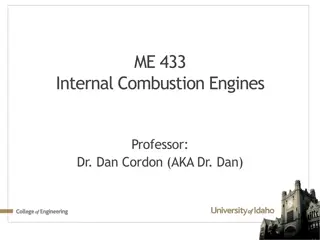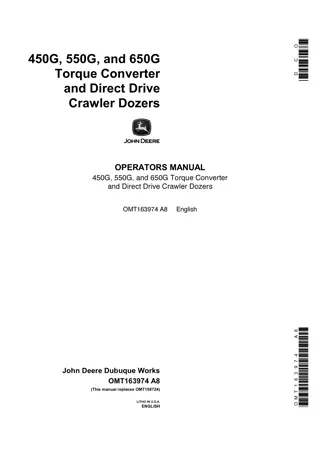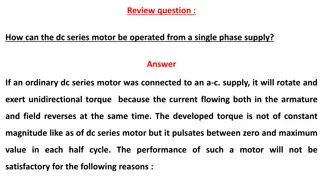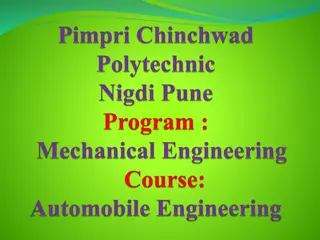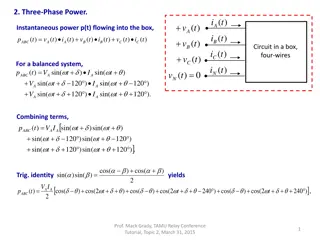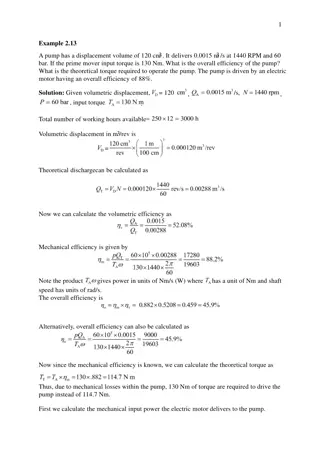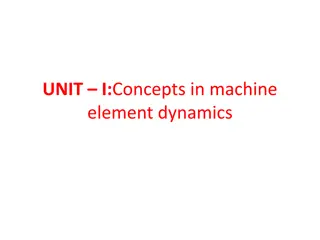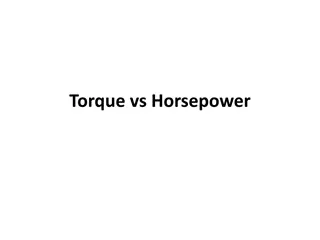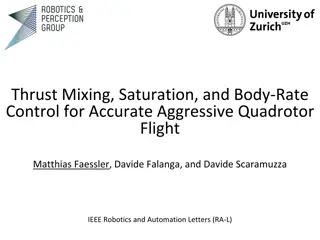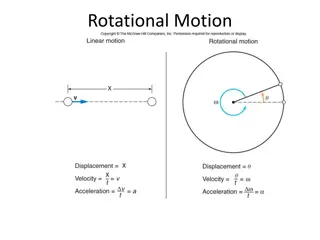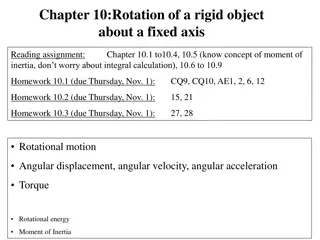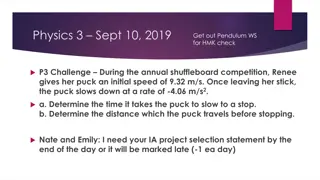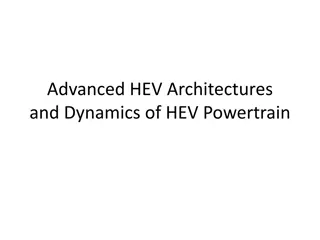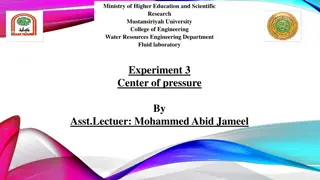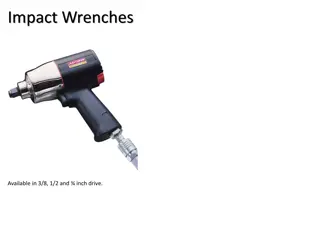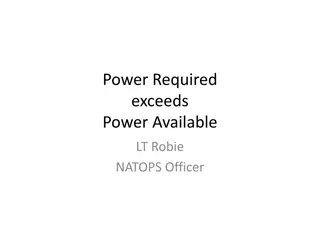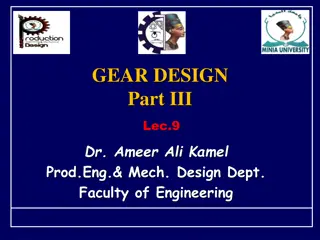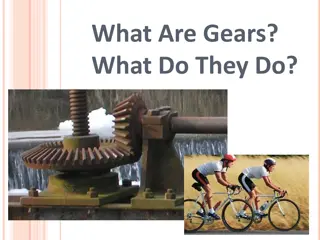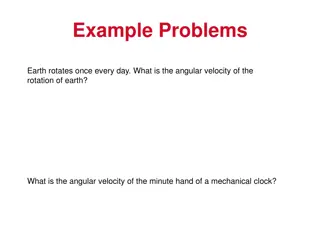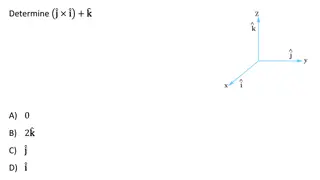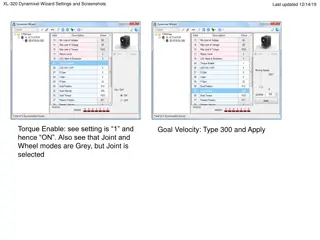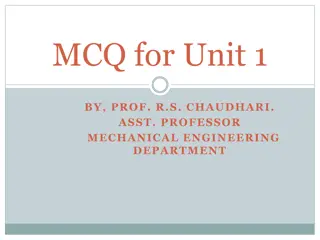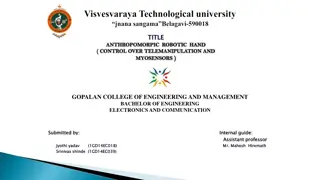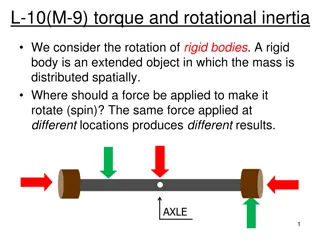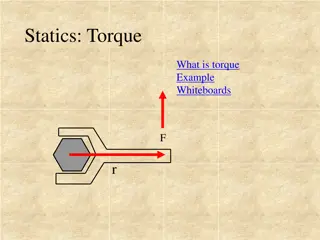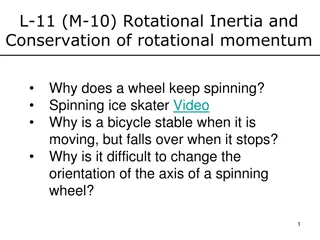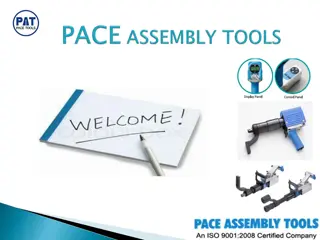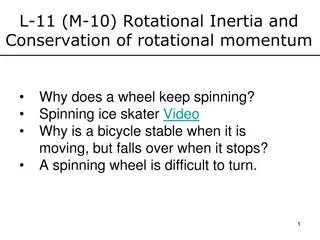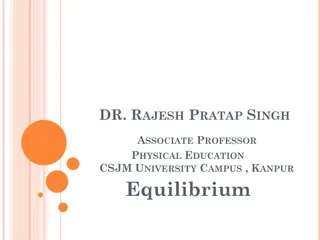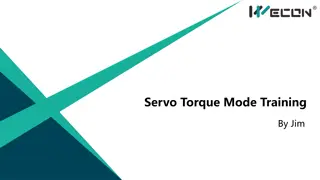Load Frequency Control in Power Systems
Electric power systems require Load Frequency Control (LFC) to maintain a uniform frequency, distribute load among generators, and manage tie-line interchange schedules. LFC detects frequency changes, generates real power commands to adjust torque, and ensures stability within specified limits. Reas
8 views • 38 slides
Angular Mechanics - Angular Momentum Concepts and Examples
Understanding angular momentum in mechanics involves reviewing linear and angular quantities, comparing angular to linear formulas, and exploring examples of angular momentum and conservation principles. The content covers key factors like angular quantities, torque, and moment of inertia, along wit
3 views • 23 slides
Understanding Mean Effective Pressure in Internal Combustion Engines
Mean Effective Pressure (MEP) is a crucial parameter in internal combustion engines, representing the average pressure exerted on the piston during the power stroke. MEP is relatively consistent for specific engine types, making it a useful predictor of torque output based on engine type and displac
10 views • 20 slides
John Deere 450G 550G and 650G Torque Converter and Direct Drive Crawler Dozers Operator’s Manual Instant Download (Publication No.OMT163974)
Please open the website below to get the complete manual\n\n\/\/
0 views • 22 slides
Understanding the Physics of an Accelerating Unicycle
Explore the intriguing concept of an accelerating unicycle in the field of physics, diving into topics such as static friction, rolling motion, and torque analysis. Discover how the interplay between forward translational acceleration and angular deceleration affects the dynamics of a unicycle, with
5 views • 16 slides
Operating a DC Series Motor from a Single Phase Supply
Connecting a DC series motor to an AC supply results in pulsating torque due to reversed current flow. This setup leads to inefficiencies and challenges such as eddy current losses and poor power factor. To improve performance, modifications like laminating core structures, using compensated winding
0 views • 23 slides
Understanding Automobile Transmission Systems: Construction and Functions
Automobile transmission systems consist of components like the clutch, gearbox, propeller shaft, and differential, working together to transmit power from the engine to the wheels. The clutch engages and disengages power smoothly, while the gearbox adjusts torque and speed based on road conditions.
0 views • 22 slides
Understanding Three-Phase Power Systems and Instantaneous Power Flow
This detailed content delves into three-phase power systems, analyzing instantaneous power flow, balanced circuits, and trigonometric calculations. It explores the concept of constant three-phase power and provides insights into the analogy of a piston engine with infinite cylinders. The data includ
2 views • 9 slides
DC Machine Armature Windings Overview
Learn about the construction and types of armature windings in DC machines, including lap wound and wave wound armatures. Discover how lap wound armatures are suitable for low voltage, high current applications, while wave wound armatures are used in high voltage, low current scenarios. Understand t
0 views • 18 slides
Pump Efficiency and Power Calculation Examples
This content provides detailed calculations for pump efficiency and power requirements in fluid power systems. It covers scenarios involving pump displacement, input torque, electric motor efficiency, volumetric and mechanical efficiencies, and power delivered to loads. The solutions include formula
2 views • 4 slides
Understanding Concepts in Machine Element Dynamics
This unit covers the concepts of D'Alembert principle, precession, gyroscopic couple, inertia force, torque, and dynamic forces associated with accelerating masses in machine elements. Students will learn how these principles affect the equilibrium and behavior of rigid bodies in rotational motion.
1 views • 8 slides
Understanding Torque and Horsepower in Mechanics
In the world of mechanics, understanding torque and horsepower is essential. Torque, measured in pounds-feet, represents the rotational force exerted on an object, while horsepower, coined by James Watt, signifies the power output of a machine. By measuring torque and RPM, one can calculate horsepow
0 views • 7 slides
Advanced Techniques for Quadrotor Flight Control
The research paper discusses thrust mixing, saturation, and body-rate control for precise and aggressive quadrotor flight. It covers system overview, dynamical system modeling, LQR control design, trajectory tracking performance, disturbance rejection, body torque estimation, and iterative thrust mi
0 views • 14 slides
Bonitron, Inc. Industrial Electronics for Power Quality and Ride-Thru Solutions
Bonitron, Inc. has been dedicated to engineering quality industrial electronics since 1962. They specialize in addressing power quality problems with VFDs and offer ride-thru solutions to maintain speed and torque during AC line sags or outages. Their UPD systems provide a reliable solution for AC d
0 views • 12 slides
Understanding Rotational Motion in Physics
Exploring rotational motion in physics involves understanding angular velocity, torque, moment of inertia, and rotational kinetic energy. This comprehensive guide covers concepts such as the conversion between degrees and radians, angular variables, Newton's second law for rotating bodies, and momen
0 views • 18 slides
Understanding Rotational Motion in Chapter 10
Exploring the concepts of rotational motion in a rigid object, focusing on angular displacement, velocity, acceleration, torque, and moment of inertia. Key topics include angular quantities, relationships between linear and angular motion, and applications in calculating rotational parameters. Pract
0 views • 29 slides
Introduction to Rotational Motion in Physics
Explore the concepts of rotational motion in physics, including angular displacement, angular velocity, and angular acceleration. Understand how objects move in circular paths and learn about the relationships between linear and rotational variables. Dive into the study of extended bodies and the dy
0 views • 15 slides
Understanding Planetary Gear Trains in Hybrid Powertrains
Hybrid powertrains utilize planetary gear trains to achieve different operating modes such as motor-alone, engine-alone, combined mode, and more. These gear trains consist of planetary gears orbiting around a central axis, enabling multiple shaft configurations for input and output. Understanding th
0 views • 55 slides
Understanding the Center of Pressure in Fluid Mechanics Experiments
The concept of center of pressure in fluid mechanics is explored through experiments to find water pressure forces on surfaces immersed in water. Theoretical background equations for partial and complete immersion are provided, along with objectives related to determining water pressure forces and c
0 views • 13 slides
Automotive Maintenance Tools Overview
Explore a range of essential automotive maintenance tools including impact wrenches, compression gauges, battery pliers, power timing lights, spark plug gauge sets, torque wrenches, retaining ring pliers, tachometers, adjustable reamers, and various types of grease guns. Each tool serves a specific
0 views • 12 slides
Understanding DRV8846 Winding Waveform and System Design Input Parameters
Explore the DRV8846 winding waveform and system design input parameters including VM, Vref, Imax, Torque DAC, RL, Rsense, and Ichop calculations. Questions arise regarding waveform stability, current saturation, and appropriate settings for optimal motor performance.
0 views • 6 slides
Helicopter Power Management Guidelines
Understanding the factors that can lead to power required exceeding power available in a helicopter is crucial for safe operation. Indications such as uncommanded descent, rotor droop, loss of tail rotor authority, and right yaw signal potential issues to watch out for. Knowing when such occurrences
0 views • 11 slides
Understanding Strength and Design of Gear Teeth
Exploring the strength and design aspects of gear teeth, this lecture covers topics such as load distribution, bending stress, form factor, number of teeth variations, gear force components, torque considerations, and the Lewis equation for gear design. The content provides insights into key factors
0 views • 30 slides
Understanding Gears and Their Applications
Gears are wheels with teeth that mesh to change speed, direction, and torque in machines. This lesson explores the diverse types of gears, their functions, and real-world examples like in bicycles and clocks. The interactive pre-lesson quiz and engaging activities further enhance understanding of ge
0 views • 17 slides
Understanding Tug of War Battle Bots: Concepts of Gear Ratio and Torque
Explore the exciting world of Tug of War Battle Bots where teams design vehicles for maximum pulling power. Learn about friction, torque, and gear ratio while modifying robots to compete in a thrilling tug of war challenge. Discover how gears, motors, and physics concepts play a crucial role in opti
0 views • 16 slides
Understanding Angular Velocity, Torque, and Conservation of Angular Momentum in Physics
Earth's angular velocity, minute hand rotation, torque calculations, application of torque in balancing seesaws, motion equations, and car deceleration scenarios are explored. Concepts like rotational inertia, kinetic energy, and conservation of angular momentum are discussed, providing a comprehens
0 views • 6 slides
Understanding Angular Momentum and Rotational Dynamics in Physics
Explore concepts related to angular momentum, torque, and rotational dynamics in physics. Learn about the behavior of spinning objects, the effects of changing moments of inertia, and how angular momentum is conserved in different scenarios.
0 views • 35 slides
XL-320 Dynamixel Wizard Settings and Screenshots Overview
Explore the XL-320 Dynamixel Wizard settings and screenshots, learn how to enable torque, set goal velocity, switch between Joint and Wheel modes, adjust goal positions, and more. Updated on 12/14/19, experience a detailed guide to configuring your XL-320 Dynamixel motor for optimal performance.
0 views • 11 slides
Multiple Choice Questions for Unit 1 by Prof. R.S. Chaudhari
This set of multiple-choice questions for Unit 1, created by Assistant Professor R.S. Chaudhari from the Mechanical Engineering Department, covers topics such as wear conditions, safe clutch and bearing designs, frictional torque, uniform pressure conditions, and more. Test your knowledge on these f
0 views • 65 slides
Anthropomorphic Robotic Hand: Telemanipulation and Myosensors Control
This project at Gopalan College of Engineering and Management focuses on the design and fabrication of a humanoid robotic hand with multiple control signals, including finger angle, actuation, touch, force feedback, and telemanipulation using a sensor glove. The mechanical aspect involves mechanizin
0 views • 30 slides
Kuken Co. Ltd.: Leading Provider of Specialized Tools Since 1968
Kuken Co. Ltd., established in March 1968 in Habikino-Shi, Osaka, is a reputable company specializing in fastening tools, sanding tools, polishing tools, drilling tools, grinding tools, cutting tools, and advanced torque control tools. Their innovative products include impact wrenches, oil pulse wre
0 views • 12 slides
Understanding Torque and Rotational Inertia in Rigid Bodies
In the realm of rigid bodies, the application of force at specific points is crucial for inducing rotation. Torque, denoted by the Greek letter tau, is the product of the force and the lever arm length, determining the rotational effect. By grasping the concept of torque and its applications, one ca
0 views • 22 slides
Understanding Torque in Mechanics
Explore the concept of torque in mechanics, which is a twisting force that can cause angular acceleration. Learn how to calculate torque by multiplying the distance from the rotation center and the applied force, and understand the importance of the angle between force and distance. Discover practic
1 views • 9 slides
Understanding Rotational Inertia and Conservation of Momentum
Rotational inertia symbolized as I is crucial in quantifying the torque needed for rotation, depending on mass distribution. Torque, rotational inertia, and mass influence an object's spinning motion, affecting stability and speed. Exploring why wheels keep spinning, ice skaters rotate faster when a
0 views • 23 slides
Enhance Your Work with KUKEN PTS Series Stand Oil Pulse Tools
KUKEN PTS series Stand Oil Pulse Tools offer innovative features like in-built controller, reaction arm with spiral retainer, ease of parameter set-up, hanging arrangement, high accuracy, and complete data recording with analysis. The tools also provide hanging and torque reaction arrangement for in
0 views • 11 slides
Understanding Rotational Inertia and Torque in Physics
Rotational inertia symbolizes how difficult it is to change the rotation of an object. It depends on mass distribution from the axis, shape, and mass. Torque needed to start rotation is proportional to rotational inertia. Smaller rotational inertia leads to faster rotational acceleration. Examples a
0 views • 23 slides
Understanding Rotational Dynamics in Physics
General announcements for a physics class covering topics on rigid bodies, torque, moment of inertia, and rotational Newton's second law. Learn about the importance of moment of inertia, calculating rotational inertia, and the application of Rotational N2L in problem-solving exercises. Explore the r
0 views • 21 slides
Understanding Equilibriums in Physics
Equilibrium in physics refers to the state of a body where there is no change in translational or rotational motion. This state can be classified into static equilibrium (when total force and torque are zero) and dynamic equilibrium (when a body is in uniform motion with zero resultant force and tor
0 views • 9 slides
Understanding Variable Valve Timing (VVT) in Internal Combustion Engines
Variable Valve Timing (VVT) optimizes engine performance by adjusting valve duration, timing, and lift according to engine speed, enhancing torque, power, and fuel efficiency. VVT operates by varying intake valve opening/closing, regulating valve timing, and adjusting lift for better volumetric effi
0 views • 14 slides
Understanding Servo Torque Mode Training by Jim
Dive into the world of servo torque mode training with Jim as your guide. Explore the principles, applications, and settings involved in torque control mode for various machines like printing presses and winding machines. Learn about internal and analog torque command inputs, torque limits, and more
0 views • 15 slides


